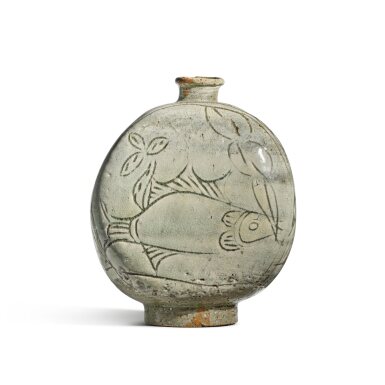SUBLIME BEAUTY: Korean Ceramics from a Private Collection
SUBLIME BEAUTY: Korean Ceramics from a Private Collection

A Buncheong sgraffiato 'fish' moonflask, Joseon dynasty, late 15th century
Lot Closed
September 22, 02:05 PM GMT
Estimate
100,000 - 150,000 USD
Lot Details
Description
A Buncheong sgraffiato 'fish' moonflask
Joseon dynasty, late 15th century
Japanese wood box (3)
Height 8⅞ in., 22.7 cm
The term buncheong was coined in the early 20th century by art historian Ko Yuseop (1905–1944). The defining feature of such wares is the presence of white slip, whether applied over the clay body or infilled into incised designs. On the present moonflask, the potter has freely and spiritedly carved through the creamy white slip with a design of swimming fish, framed by charming floral motifs on the narrow sides, revealing the gray clay body beneath. The entire vessel is covered with a translucent celadon-tinged glaze suffused with crackle, which pools into a crystal clear, blue-green color in the recesses.
A vessel of this form would have been first created on a wheel and then flattened by hand on either side. As such, such flasks often display a unique, slightly asymmetrical shape that hint at their hand-finished nature and many buncheong wares are valued by connoisseurs for their charming idiosyncrasies.
While Joseon period potters may have invented the design of swimming fish themselves, they may have also been inspired by motifs on Cizhou ceramics or blue and white porcelain from China. Indeed, the spirited sgraffiato decoration on Cizhou vessels bear close similarities with those on buncheong ware. Cizhou ware was exported in great quantities to Korea, exemplified by excavated finds from the ship that sank in 1323 off the Sinan coast (see Special Exhibition of Cultural Relics Found off Sinan Coast, National Museum of Korea, Seoul, 1977, cat. nos 36-37, 220-222).
The present vessel was likely used for serving wine. Compare two moonflasks attributed to the second half of the 15th century, very similarly decorated with a pair of fish on one side framed by floral motifs on the narrow borders: the first in the collection of the Museum of Fine Arts, Boston (accession no. 99.298), illustrated in Jane Portal, MFA Highlights Arts of Korea, Boston, 2012, pl. 114; the second in the collection of Leeum, Samsung Museum of Art, Seoul, and was included in the exhibition Poetry in Clay: Korean Buncheong Ceramics from Leeum, Samsung Museum of Art, The Metropolitan Museum of Art, New York, and the Asian Art Museum, San Francisco, 2011, cat. no. 40. Another moonflask with a single fish on one side and an abstract geometric design on the other was sold at Christie’s New York, 18th April 2018, lot 133. For buncheong moonflasks carved with other designs, see two examples, one carved with flowers and the other with leaves, in the Asian Art Museum, San Francisco (accession nos 2016.118 and 2016.117); a flask decorated with peonies in the Metropolitan Museum of Art, New York (accession no. 1986.305); and a further example with a stylized flower in the National Museum of Korea, Seoul (accession no. Sinsu 12380). For related designs of fish, see a drum-shaped bottle illustrated in Poetry in Clay, op.cit., cat. no. 41.
